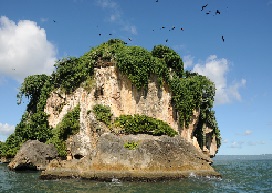The Los Haitises National Park is a paradise in which travelers who love nature will see all their expectations fulfilled. Created in 1976, it is located in the north-east of the Dominican Republic, on Bahía de Samaná bay, and located in Savana de la Mar and the provinces of Monte Plata and Samaná. Its name means high land or mountainous land, although the hills or magotes (elevations of limestone rock very common in the Caribbean) reach no higher than 40 meters, and it offers a great number of hills, corridors and valleys, as well as caves full of pictographs and petroglyphs.
Its hydrographic configuration divides the Park into two zones: the area of the Yuma River, with two estuaries and several rivers, and the Miches zone with its lagoons and Savana de la Mar. Its land formation, on the other hand, includes a system of caves in which the paintings in those of La Reyna, San Gabriel and La Línea are a prominent feature. The mogotes and cays that make up the zone, despite having the same karst origin, are different in the valleys they form: the cay waters of the Bahía de Samaná are closer to sea level than the rest and are thus occupied by sea water.
The flora of Los Haitises is heavily affected by the rainfall of the region, one of the highest in the country. It has two very different zones: that of the humid subtropical forest and that of the very humid subtropical forest, both with their most representative species: carimba santa, cedar tree, ceiba tree, mahogany tree and hojancha, in addition to multiple species of orchid. Therefore, an excursion in a row boat is one of the best options for tourists. These small boats are not usually very expensive and can be hired, with a bit of bartering, at Caño Hondo or Savana de la Mar, where you can avail of the services of a guide which will be absolutely necessary for exploring certain zones and enjoying the park in all its splendor.
For its part, the fauna is one of the richest and most representative of the country. It boasts a large number of endemic, native and migratory species, including the pelican, the scissor-tailed flycatcher, the parrot and several species of owl. In addition, you can find manatees in the mangrove swamps of the cays, hutias, a large population of bats in the coves, and a great number of reptiles, including the boa constrictor and sea turtles.
But, in addition, the landscape is one of the most striking in the whole country. The stunning Bahía de San Lorenzo bay and its multiple islets full of vegetation, or the Cayo de los Pájaros cay, continually flown over by scissor-tailed flycatchers and pelicans, will enable the visitor to add a considerable number of photos to their collection.

